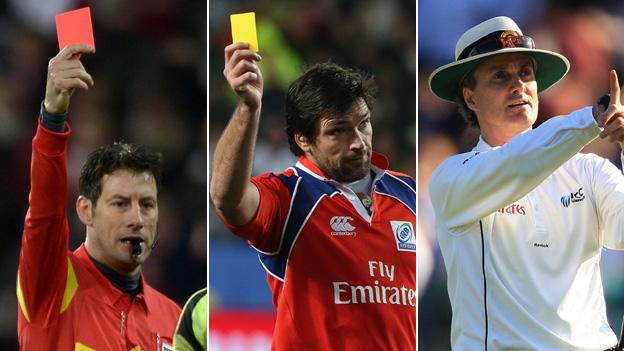Cricket to introduce sendings-off & bat restrictions after MCC approval
- Published

Australia's Glenn McGrath was jokingly shown a red card by umpire Billy Bowden during the first ever Twenty20 international in 2005 after he pretended to bowl underarm
Cricket will introduce sendings-off, award penalty runs for poor behaviour and limit bat sizes after lawmakers the MCC approved the changes.
Player offences will be measured across four levels and punishments range from giving away five runs to being dismissed temporarily or permanently.
Batsmen will also now not be run out if their bat loses contact with the ground after being grounded behind the crease.
The new laws will come into effect from 1 October, 2017.
MCC (the Marylebone Cricket Club) is the guardian of the laws and spirit of the game, and has a world cricket committee, external - established in 2006 - of 12 current and former top international players which made its recommendations last December.
This is the first time a new code of laws has been written since 2000.
The mode of dismissal of a bowler running out a batsman at the non-striker's end has also been changed.
Bowlers will now be able to perform the run-out "to the instant when the bowler would normally have been expected to release the ball", rather than before entering his or her delivery stride, as was the previous rule.
When would players be ejected?
Offences and punishments include:
Level 1
excessive appealing
showing dissent at an umpire's decision
Punishment - following an official warning, a second offence will result in five penalty runs being conceded
Level 2
throwing the ball at a player
making deliberate physical contact with an opponent
Punishment - five penalty runs being conceded
Level 3
intimidating an umpire
threatening to assault another player, team official or spectator
Punishment - five penalty runs being conceded and the removal of the offending player for a set number of overs
Level 4
threatening an umpire
any other act of violence on the field of play
Punishment - the removal of the offending player for the remainder of the match
"We felt the time had come to introduce sanctions for poor player behaviour and research told us that a growing number of umpires at grassroots level were leaving the game because of it," MCC head of cricket John Stephenson said.
Bat edges and depths to be limited
Following much debate in the past few years over bat sizes, and a call for restrictions from the International Cricket Council in June,, external specific size limitations to the edge and depth of bats will be added to the laws as the committee believes "the balance of the game has tilted too far in the batsman's favour" - with some mis-hit shots clearing the boundary for six.
Bat edges will have a maximum allowance of 40mm and bat depths must not exceed 67mm (60mm plus an allowance of 7mm for a possible curve on the face of the bat) and the width can be up to 108mm.
"The bat size issue has been heavily scrutinised and discussed in recent years. We believe the maximum dimensions we have set will help redress the balance between bat and ball, while still allowing the explosive, big hitting we all enjoy," Stephenson said.
While a bat gauge will be used to enforce the new restriction in the professional game, a moratorium will allow amateur players to continue to use their existing bats which may be in breach of the new law.
- Published12 July 2016

- Published12 August 2014
